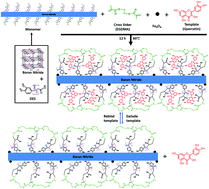New types of two-dimensional (2D) boron nitride (BN) were developed as a 2D scaffold material. After modification with ternary deep eutectic solvents (DES, ChCl–caffeic acid–ethylene glycol), the processed BN was applied to the preparation of magnetic molecularly imprinted polymers (MMIPs). In the polymerization of MMIPs, DESs and hydrophobic Fe3O4 magnetite were applied as the functional monomer and magnetically susceptible component, respectively. A 2D ellipsoid material was formed successfully by polymerization on the surface of the processed BN. The proposed 2D-MMIPs were characterized by Fourier transform infrared spectroscopy, thermogravimetric analysis, scanning electron microscopy, and nitrogen sorption analysis techniques. The surface area of the 2D-MMIPs was increased using eco-friendly chemicals. The proposed 2D-MMIPs had a 2D oblate structure and a large surface area. The 2D-MMIPs were used for the preconcentration of flavonoids from Ginkgo biloba leaf extracts. High performance liquid chromatography–ultraviolet analysis revealed that the 2D-MMIPs have higher recoveries for the flavonoids (quercetin 96.8%, isorhamnetin 93.6% and kaempferol 94.8%) in Ginkgo biloba leaves than common MMIPs.
